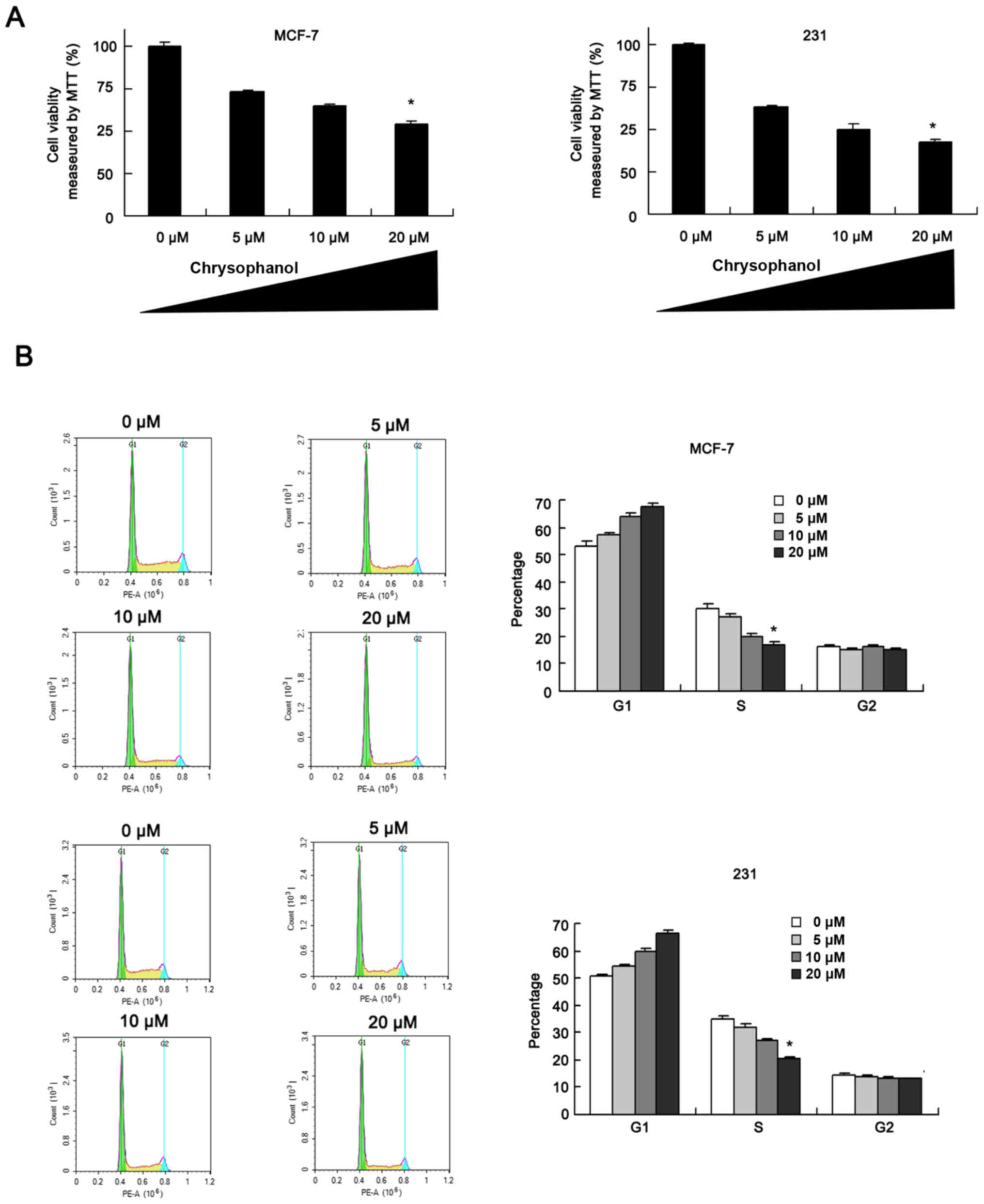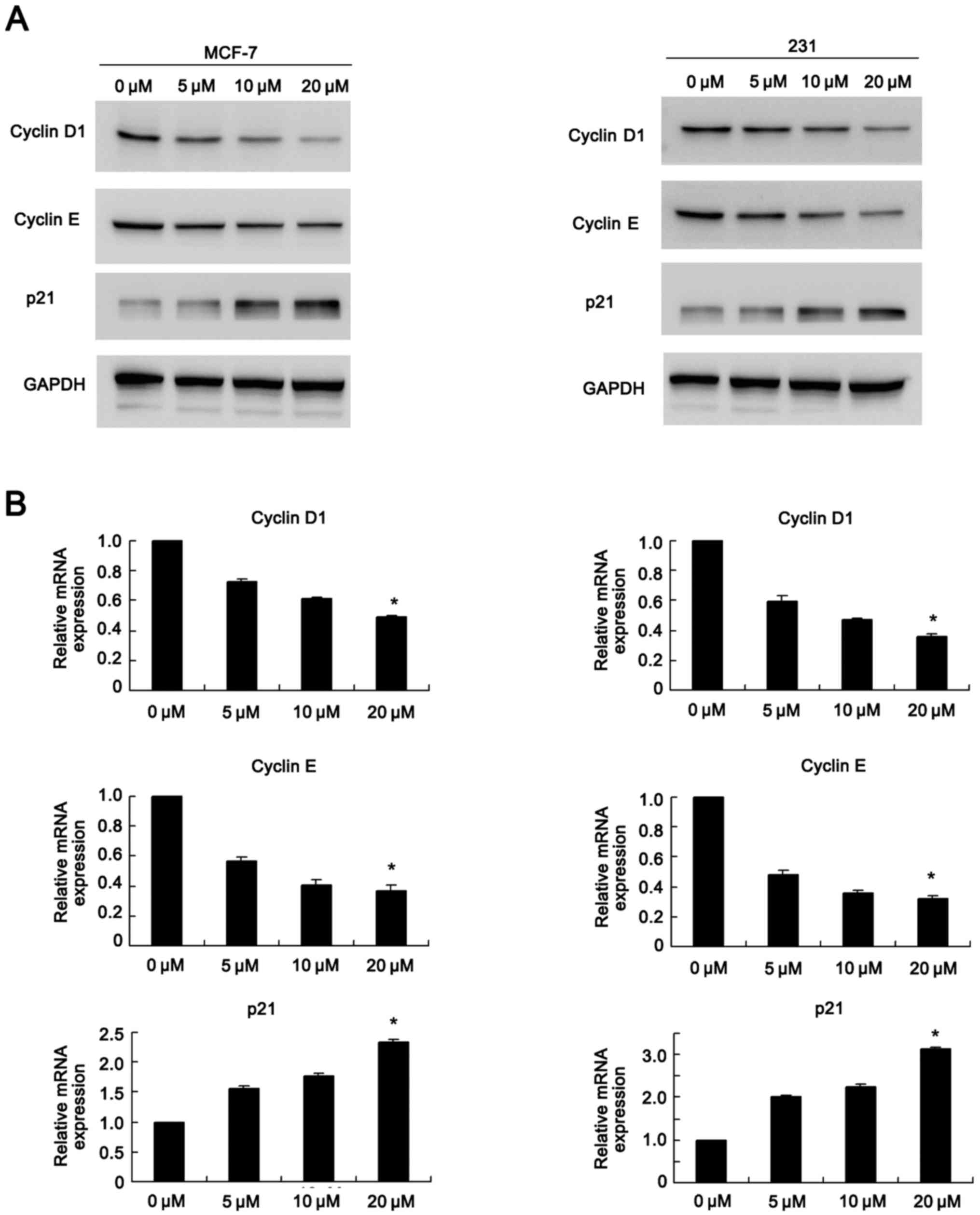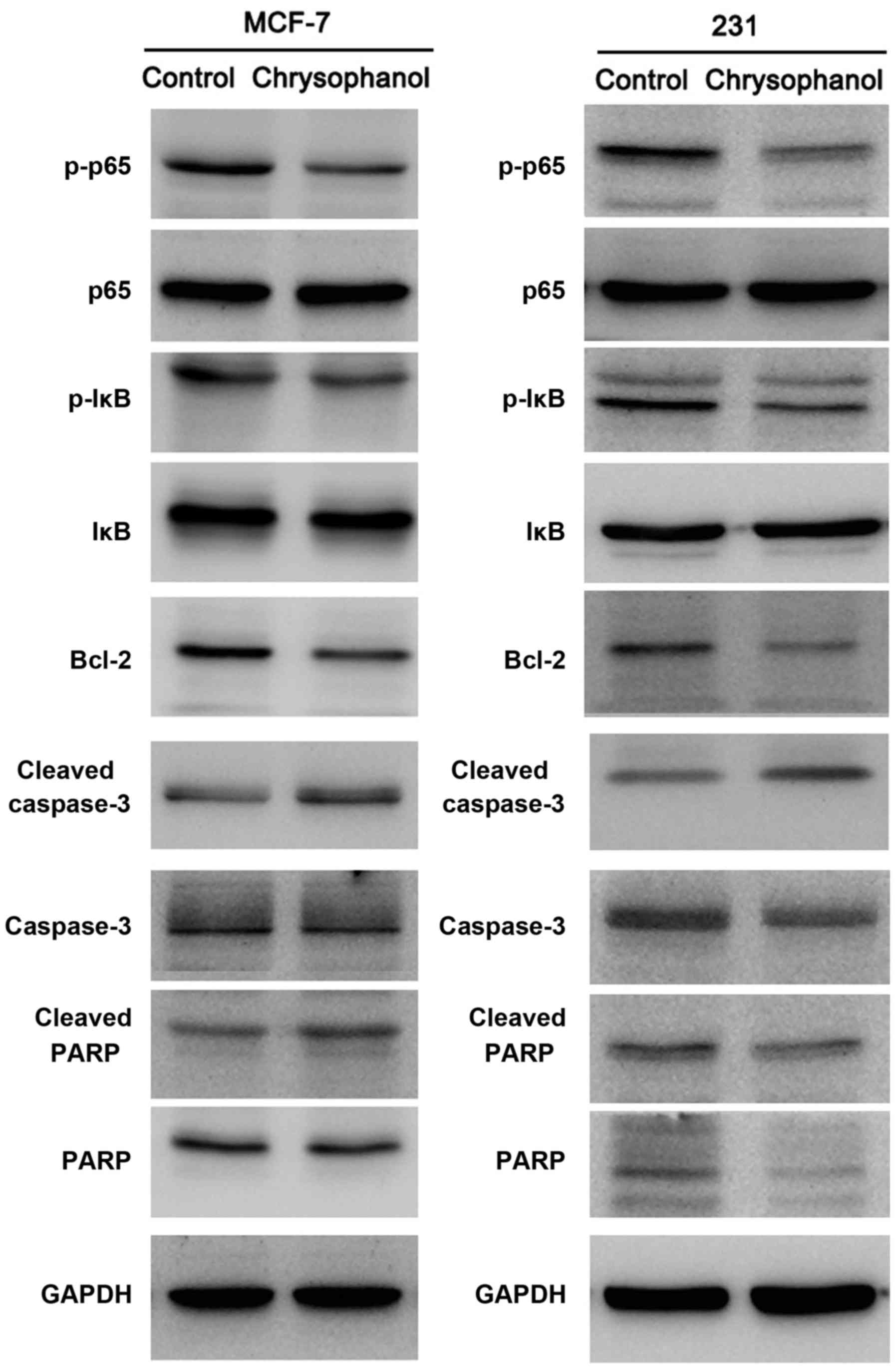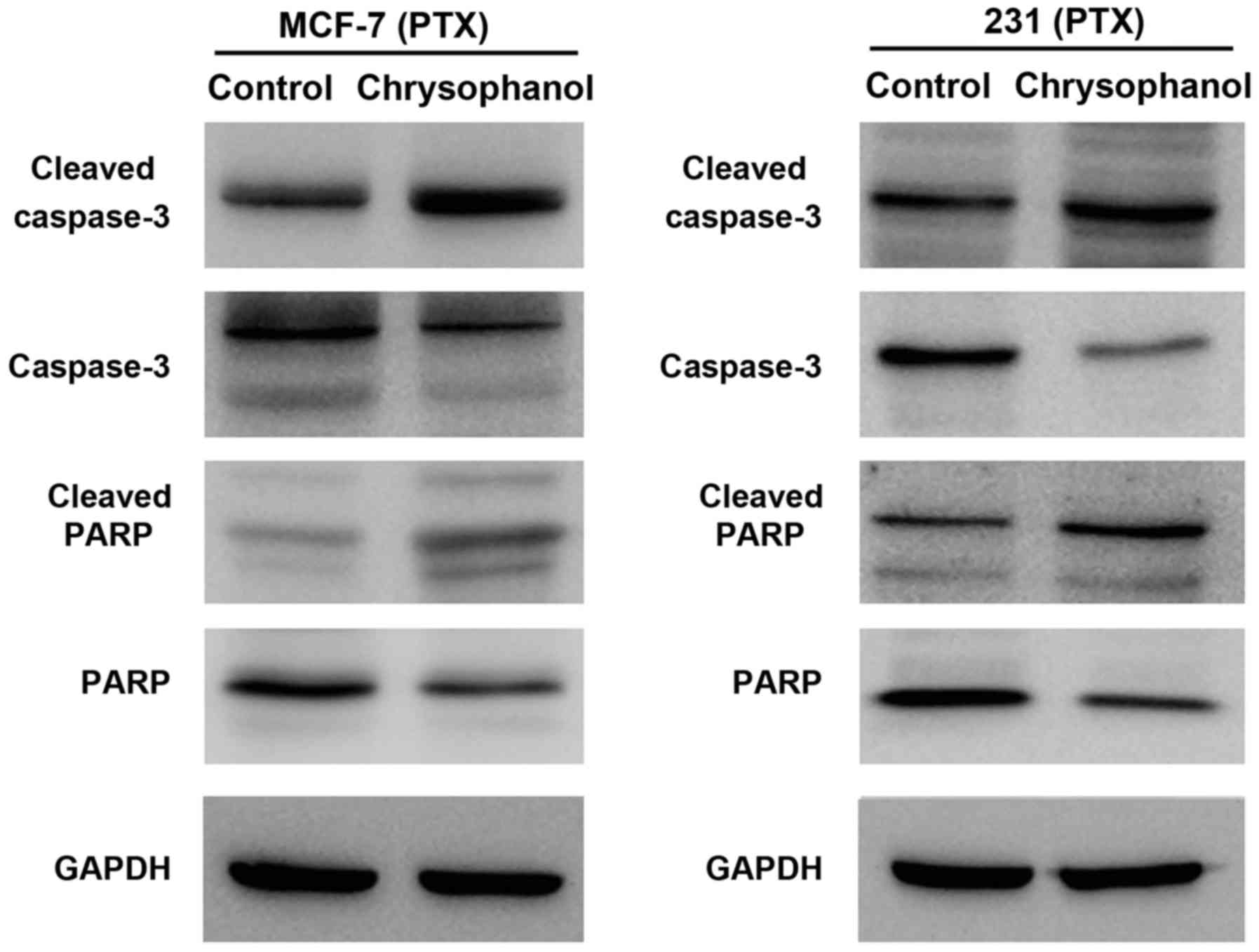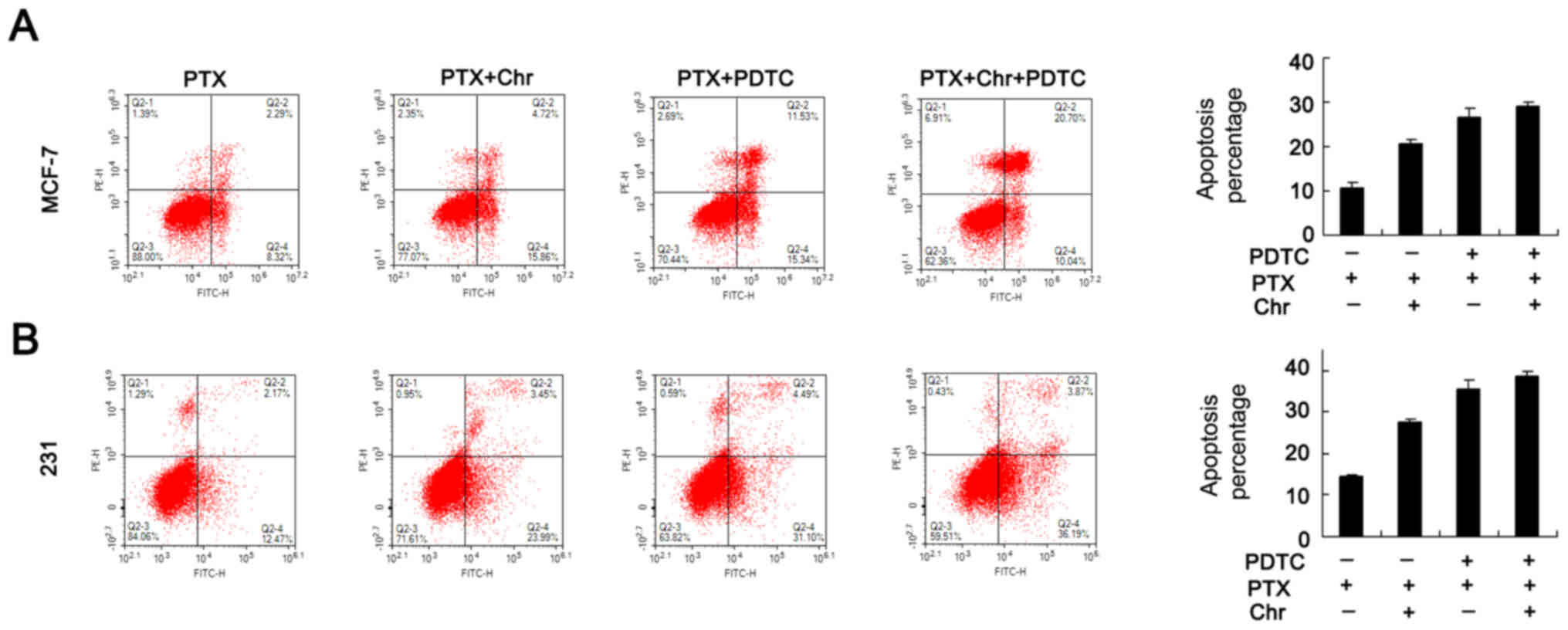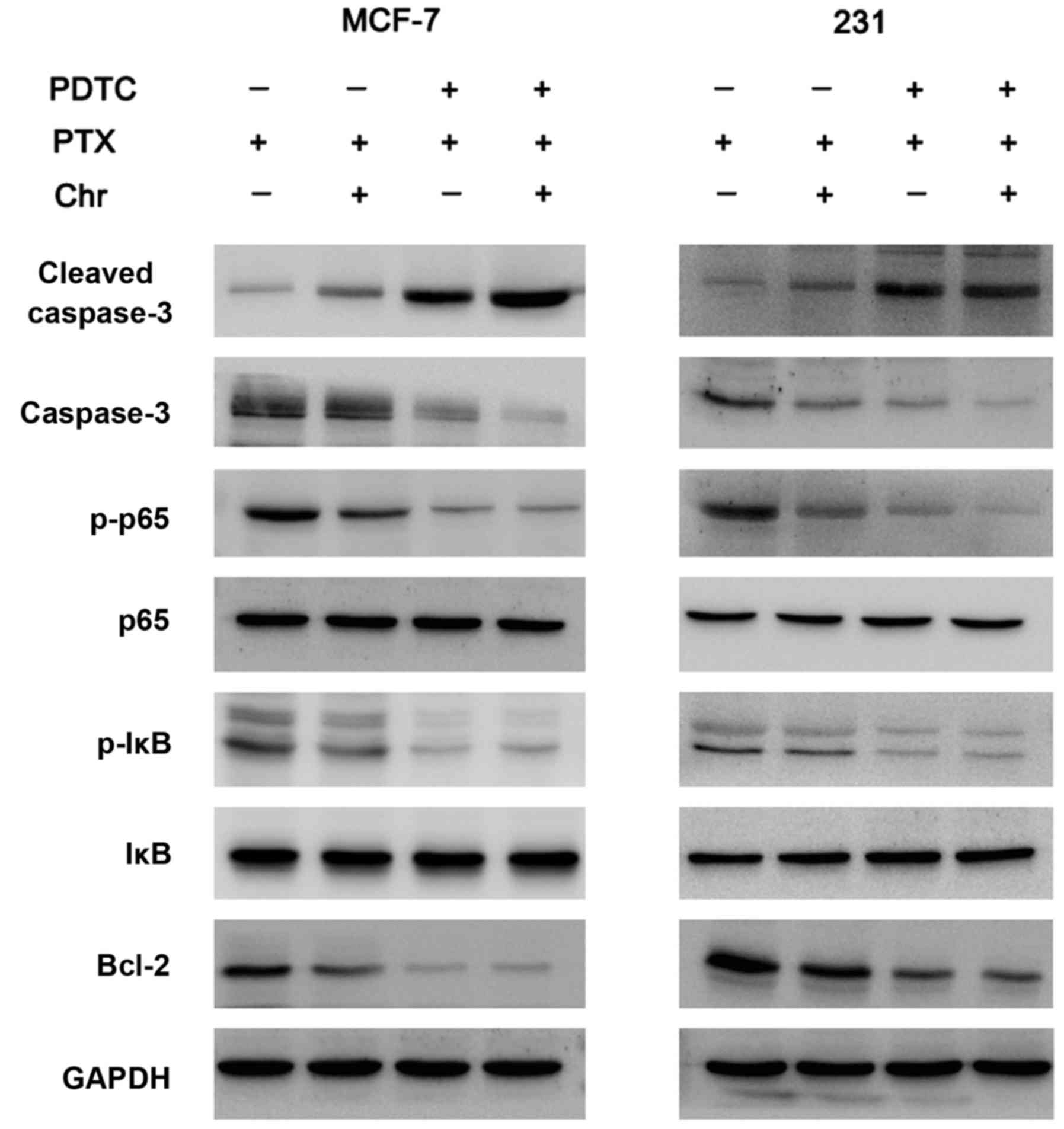Chrysophanol inhibits proliferation and induces apoptosis through NF-κB/cyclin D1 and NF-κB/Bcl-2 signaling cascade in breast cancer cell lines
- Authors:
- Published online on: January 17, 2018 https://doi.org/10.3892/mmr.2018.8443
- Pages: 4376-4382
-
Copyright: © Ren et al. This is an open access article distributed under the terms of Creative Commons Attribution License.
Abstract
Introduction
Breast cancer remains the most common cancer in women worldwide and its mortality rate is increasing. This disease may cause serious harm to physical and mental health of women. Surgery remains the primary treatment in most cases and entails the complete removal of the primary tumour in the breast (1,2). Traditional Chinese herbal medicine (CHM), as an adjunctive treatment following surgery, radiotherapy and chemotherapy, may prolong survival time and improve the quality of life of breast cancer patients.
Chrysophanol (1,8-Dihydroxy-3-methyl-9,10-anthraquinone) belongs to anthraquinone family, which also contains emodin, aloe-emodin, rhein, and physcion.
Derivatives of anthraquinone family are natural products, which were mainly extracted from rhubarb and used in CHM (3–5). As a palliative treatment, CHM was commonly used with oral administration for different types of cancers in China (6–8).
There were some reports indicating that rhubarb extracts induced apoptosis or inhibit migration of cancer cells (9,10). For example, emodin extracted from rhubarb root has anti-cancer effects in numerous cancers such as prostate, breast and cervical cancers (11–15). Chrysophanol was also reported for its anti-cancer role, showing that it inhibits viability of colon cancer cells through inhibition of the NF-κB-mediated signaling cascades (16). In choriocarcinoma, Chrysophanol induced cell apoptosis by regulating production of reactive oxygen species (ROS) through AKT and ERK1/2 signaling pathways (17). Chrysophanol induces necrosis in A549 cells through increasing ROS and decreasing the level of mitochondrial membrane potential (3). Chrysophanol also impairs mitochondrial ATP synthesis in Hep3B cells (4). However, whether chrysophanol play a role in breast cancer development is still unknown. This study aims to find out the biological effects of chrysophanol on breast cancer and the potential mechanism.
Materials and methods
Chemicals
Chrysophanol (cat no. 01542) and Paclitaxel (cat no. 1491332) were purchased from Sigma-Aldrich (St. Louis, MO, USA). NF-κB inhibitor (BAY 11–7082; cat no. S1523) was purchased from Beyotime Institute of Biotechnology (Shanghai, China).
Cell culture
Breast cancer cell line MCF-7 and MDA-MB-231 were purchased from the American Type Culture Collection (Manassas, VA, USA) and cultured in RPMI-1640 (Invitrogen; Thermo Fisher Scientific, Carlsbad, CA, USA) with 10% FBS (Invitrogen; Thermo Fisher Scientific) and 0.01 mg/ml human recombinant insulin (cat no. I3536; Sigma-Aldrich). The cultures were maintained at 37°C in a humidified incubator containing 5% (v/v) CO2 in air. Cells were seeded at a density of 1×106 cells/ml in 6-well plates.
MTT assay
MCF-7 cells (5×103/well) were plated in 96-well plates and cultured overnight. MTT solution (volume, 20 µl; concentration, 5 mg/ml; Sigma-Aldrich) was added to each well and then incubated for another 4 h. The supernatant was removed and DMSO (150 µl) was added for test preparation. Absorbance was measured at 490 nm. Data were obtained from triplicate wells per condition.
Flow cytometry for cell cycle and apoptosis analysis
Cells in 6-well plates were collected using 0.25% trypsase 24 h after chrysophanol treatment. Cells were washed twice with PBS butter and then resuspended in 250 µl of binding buffer. Cells were fixed in 1% paraformaldehyde for 24 h and then stained with 5 mg/ml propidium iodide for cell cycle analysis. Cells were stained with propidium iodide and Annexin V/FITC for cell apoptosis analysis. Stained cells were analyzed by FACS Calibur flow cytometer (BD Biosciences, San Diego, CA, USA) after incubation in the dark for 15 min.
Western blot analysis
Total protein of MCF-7 cells was extracted using lysis buffer (Pierce Biotechnology, Inc., Rockford, IL, USA) and Bradford method was used to quantify the protein. When SDS-PAGE assay was performed, 30 µg of the protein was separated and then transferred to polyvinylidene fluoride membranes (Millipore Corp., Billerica, MA, USA). For primary antibody incubation, cleaved caspase 3, caspase 3, cleaved PARP, PARP, p-p65, p65, p-IκB, IκB, Bcl-2 (1:1,000; Cell Signaling Technology, Inc., Danvers, MA, USA), and GAPDH (1:2,000; Cell Signaling Technology, Inc.) were incubated overnight at 4°C. For secondary antibody incubation, peroxidase-coupled anti-mouse/rabbit IgG (1:1,000; Cell Signaling Technology, Inc.) was incubated at 37°C for 2 h. Sample protein was visualized using ECL (Pierce Biotechnology, Inc.) and detected using a DNR BioImaging System (DNR Bio-Imaging Systems, Ltd., Jerusalem, Israel). Relative protein levels were quantified using ImageJ software.
Realtime quantitative PCR
Total RNA was isolated from MCF-7 cells using TRIzol reagent (Thermo Fisher Scientific) following the manufacturer's instructions. Then, reverse transcription of total RNA into cDNA was performed using the Reverse Transcription System (A3500; Promega Corp., Madison, WI, USA) and PrimerScript RT Master Mix kit (Takara Bio, Dalian, China). Briefly, a total 20 µl of reverse-transcription reaction solution was prepared containing 4 µl of 5X RT Master Mix and 800 ng RNA and the mixture was reacted at 85°C for 2 min and 37°C for 30 min. PCR was performed using 7500 Realtime PCR System (Applied Biosystems Life Technologies, Foster City, CA, USA) and SYBR-Green master mix kit (Applied Biosystems Life Technologies). The relative expression of target genes were calculated as ΔCq=Cq gene-Cq reference, and the fold change of target gene expression was calculated by the 2−ΔΔCq method. GAPDH was used as the reference gene. Experiments were repeated in triplicate. Primer sequences were listed as follows: Cyclin D1 forward TGGAGGTCTGCGAGGAACA, cyclin D1 reverse TTCATCTTAGAGGCCACGAACAT; cyclin E forward AGCCAGCCTTGGGACAATAAT, cyclin E reverse GAGCCTCTGGATGGTGCAAT; p27 forward CTGCAACCGACGATTCTTCTACT, p27 reverse CTTCTGAGGCCAGGCTTCTT; GAP DH forward AAGATCATCAGCAATGCCTCCT, GAP DH reverse TGGTCATGAGTCCTTCCACGAT.
Statistical analysis
Statistical analyses were performed using SPSS version 16 for Windows. The Student's t-test was used to compare differences between control and treatment groups. P<0.05 was considered to indicate a statistically significant difference.
Results
Chrysophanol inhibits breast cancer cell proliferation and cell cycle progression
MCF-7 and MDA-MB-231 cells were employed to explore effect of chrysophanol on breast cancer. Cells were treated with chrysophanol at the concentrations of 0, 5, 10, 20 µM. MTT assay and cell cycle analysis were performed. As shown in Fig. 1A, proliferation rates of MCF-7 and MDA-MB-231 cells were decreased significantly when treated with chrysophanol in a concentration-dependent manner after 48 h treatment. Cycle analysis results showed that G1 percentage increased while S percentage decreased after chrysophanol treatment (24 h) in a concentration-dependent manner (Fig. 1B), indicating chrysophanol could arrest breast cancer cells at G1-S cell cycle checkpoint.
Chrysophanol regulates cell cycle related proteins
Western blot analysis and real-time quantitative PCR were used to determine the change of cycle related genes (Fig. 2). Western blot analysis results showed that chrysophanol exposure dramatically inhibited expression of cyclin D1, cyclin E while upregulated p21 levels in a concentration dependent manner in both MCF-7 and MDA-MB-231 cell lines (0, 5, 10, 20 µM, 24 h) (Fig. 2A). In accordance with western blot analysis results, PCR results showed cyclin D1 and cyclin E mRNA levels decreased when treated with chrysophanol. The mRNA expression of p27 was upregulated in both cell lines in a dose dependent manner (0, 5, 10, 20 µM, 24 h) (Fig. 2B).
Chrysophanol regulates cell apoptosis and related proteins
To explore effect of chrysophanol on cell apoptosis, MCF-7 and MDA-MB-231 cells were treated with chrysophanol (20 nM, 24 h) and stained with Annexin V/PI. As shown in Fig. 3 A&B, percentage of apoptotic cells was increased significantly when treated with chrysophanol in both cell lines. In order to explore the role of chrysophanol on chemosensitivity, we adopted 5 nM paclitaxel (PTX) to treat MCF-7 and MDA-MB-231 cell lines for 12 h and examined apoptosis rate after chrysophanol (20 nM, 24 h) treatment. As shown in Fig. 3A and B, chrysophanol significantly increased apoptosis rate in paclitaxel treated breast cancer cells.
Next, expression of apoptosis related protein was examined using western blot analysis and the results showed that chrysophanol treatment upregulated cleaved caspase 3 and cleaved PARP levels in both cell line (Fig. 4). In cells treated with paclitaxel (5 nM, 12 h), chrysophanol also significantly upregulated caspase 3 and PARP cleavage in both cell lines (Fig. 5).
Chrysophanol regulates chemosensitivity through NF-κB signaling pathway
To explore the potential mechanism of chrysophanol in MCF-7 and MDA-MB-231 cell lines, we examined several signaling pathways which is related to cancer cell proliferation and chemoresistance. Western blot analysis showed that expression of Bcl-2, p-IκB, p-p65 expression were significantly decreased after treatment with chrysophanol (Fig. 4).
The above results demonstrated that NF-κB activity was suppressed after chrysophanol treatment. Bcl-2 was reported as a downstream target of NF-κB signaling, which serves as a potent inhibitor of apoptosis and an indicator of chemoresistance. To confirm if chrysophanol mediated cell behavior was dependent on NF-κB signaling pathway, cancer cells were treated with NF-κB inhibitor (10 µM). Apoptosis analysis was performed and the results showed that difference of PTX induced apoptosis rate between control+ PDTC and chrysophanol+PDTC groups was not as significant as that between control and chrysophanol groups (Fig. 6). As shown in Fig. 7, PDTC blocked NF-κB signaling by reducing p-p65 and p-IκB expression. Apoptosis analysis was performed and the results showed that difference of PTX induced apoptosis rate between control+ PDTC and chrysophanol+PDTC groups was not as significant as that between control and chrysophanol groups (Fig. 6 A&B). In addition, in PDTC treated cells, the role of chrysophanol on Bcl-2 reduction was not significant, suggesting chrysophanol induced chemosensitivity through inhibition of NF-κB/Bcl-2 signaling (Fig. 7).
Discussion
In this study, we used breast cancer cell lines MCF-7 and MDA-MB-231 to examine the anti-tumor effect of chrysophanol. MCF-7 is Luminal A subtype cell with positive ER, PR status and negative HER2 status. MDA-MB-231 cell line is a Basal subtype with negative ER, PR and HER2 status (Triple negative). We chose these 2 cell lines because they represent the most common subtype (Luminal A) and the chemotherapy resistant subtype (Triple negative). As shown in MTT assay, chrysophanol inhibited the proliferation of MCF-7 and MDA-MB-231 cells in a dose-dependent manner. In addition, cell cycle progression was arrested at G1-S point with downregulation of cyclin family proteins such as cyclin D1 and cyclin E. When checking signaling pathways involved in chrysophanol mediated effects, we found that chrysophanol facilitated PTX induced apoptosis and downregulated Bcl-2. Interestingly, we found that chrysophanol inactivated IκB and p65 phosphorylation, which are pivotal tyrosine kinases of NF-κB (18). To confirm the involvement of NF-κB in the anti-cancer effect of chrysophanol, we used NF-κB inhibitor PDTC. In PDTC treated cells, the effect of chrysophanol on Bcl-2 was not significant compared with normal MCF-7 and MDA-MB-231 cells, suggesting chrysophanol exert its effect through its inhibition of NF-κB activity.
First, we demonstrated that chrysophanol reduced breast cancer cell growth, cell cycle and related proteins in a dose dependent manner. Further study suggested chrysophanol could inhibit NF-κB activity. NF-κB activation has been found in many human cancers, which plays important roles in cancer proliferation, invasion and metastasis and associates with poor survival rate (19–21). cyclin D1 and cyclin E play pivotal roles in cell growth of many malignant cancers (22,23). NF-κB could upregulate its downstream molecule cyclin D1 through phosphorylation of p65 and IκB, which induced NF-κB p65 nuclear localization and subsequent transcriptional activation of cyclin related proteins (24). Our result was in accordance with these report, suggesting chrysophanol inhibits cancer cell growth through modulation of NF-κB/cyclin signaling.
In addition to the role of chrysophanol on NF-κB related cancer proliferation, we showed that chrysophanol upregulates apoptosis, which is in parallel with downregulation of Bcl-2 protein and cleavage of caspase 3& PARP. Furthermore, chrysophanol pretreatment enhanced the apoptosis inducing effect of paclitaxel in breast cancer cell lines, suggesting combined treatment would significant enhance the biological effect of PTX. In breast cancer cells, NF-κB signaling activates Bcl-2 which plays a central role in cancer cell survival and chemoresistance. Bcl-2 is overexpressed in breast cancers and serves as an indicator of chemotherapy response. Many studies demonstrated that targeting Bcl-2 inhibits tumor growth and reduces the development of chemoresistance (25,26). Mitochondrial membrane permeability is regulated by the Bcl-2 family of proteins. Compromised mitochondrial membrane integrity leads to downregulated mitochondrial potential. Thus NF-κB signaling plays an important role during regulation of mitochondrial potential in cancer cells (27,28). These Bcl-2 family anti-apoptotic proteins selectively bind to Bax and block its oligomerization. Bax can then insert into the mitochondrial membrane, compromising its integrity and releasing cytochrome c, which leads to activation of caspase 3 and apoptosis. PARP could be cleaved by caspase 3 in vitro, which is involved in DNA repair in response to environmental stress and serves as a marker of cells undergoing apoptosis (29,30). Thus we postulate that chrysophanol inhibits NF-κB/Bcl-2 signaling, which in turn leads to caspase 3/PARP cleavage.
To further validate the relationship between chrysophanol, apoptosis and NF-κB/Bcl-2 signaling. NF-κB inhibitor PDTC was adopted. In PDTC treated cells, the promoting effect of chrysophanol on PTX induced apoptosis was not significant. The change of Bcl-2 induced by chrysophanol was also diminished. Together, our results revealed that chrysophanol targets NF-κB/Bcl-2 to suppress breast cancer cell proliferation and chemoresistance, suggesting chrysophanol could be used as a chemotherapeutic agent towards breast cancer cells.
In conclusion, our study demonstrated that chrysophanol inhibits malignant growth and cell cycle of breast cancer cells by inhibiting phosphorylation of NF-κB and its downstream NF-κB/cyclin D1 pathways. Chrysophanol also inhibits NF-κB/Bcl-2 pathway, which facilitates PTX induced apoptosis. Chrysophanol may serve as a novel therapeutic drug for human breast cancer.
Acknowledgements
The present study was supported by a grant from the National Nature Science Foundation of Liaoning Province (grant no. 201602306).
References
|
Golshan M, Cirrincione CT, Sikov WM, Carey LA, Berry DA, Overmoyer B, Henry NL, Somlo G, Port E, Burstein HJ, et al: Impact of neoadjuvant therapy on eligibility for and frequency of breast conservation in stage II–III HER2-positive breast cancer: Surgical results of CALGB 40601 (Alliance). Breast Cancer Res Treat. 160:297–304. 2016. View Article : Google Scholar : PubMed/NCBI | |
|
Tsuyuki S, Senda N, Kanng Y, Yamaguchi A, Yoshibayashi H, Kikawa Y, Katakami N, Kato H, Hashimoto T, Okuno T, et al: Evaluation of the effect of compression therapy using surgical gloves on nanoparticle albumin-bound paclitaxel-induced peripheral neuropathy: A phase II multicenter study by the kamigata breast cancer study group. Breast Cancer Res Treat. 160:61–67. 2016. View Article : Google Scholar : PubMed/NCBI | |
|
Ni CH, Yu CS, Lu HF, Yang JS, Huang HY, Chen PY, Wu SH, Ip SW, Chiang SY, Lin JG and Chung JG: Chrysophanol-induced cell death (necrosis) in human lung cancer A549 cells is mediated through increasing reactive oxygen species and decreasing the level of mitochondrial membrane potential. Environ Toxicol. 29:740–749. 2014. View Article : Google Scholar : PubMed/NCBI | |
|
Ni CH, Chen PY, Lu HF, Yang JS, Huang HY, Wu SH, Ip SW, Wu CT, Chiang SY, Lin JG, et al: Chrysophanol-induced necrotic-like cell death through an impaired mitochondrial ATP synthesis in Hep3B human liver cancer cells. Arch Pharm Res. 35:887–895. 2012. View Article : Google Scholar : PubMed/NCBI | |
|
Lu CC, Yang JS, Huang AC, Hsia TC, Chou ST, Kuo CL, Lu HF, Lee TH, Wood WG and Chung JG: Chrysophanol induces necrosis through the production of ROS and alteration of ATP levels in J5 human liver cancer cells. Mol Nutr Food Res. 54:967–976. 2010. View Article : Google Scholar : PubMed/NCBI | |
|
Zhao L, Zhao AG, Zhao G, Xu Y, Zhu XH, Cao ND, Zheng J, Yang JK and Xu JH: Survival benefit of traditional chinese herbal medicine (a herbal formula for invigorating spleen) in gastric cancer patients with peritoneal metastasis. Evid Based Complement Alternat Med. 2014:6254932014. View Article : Google Scholar : PubMed/NCBI | |
|
Hun Lee J, Shu L, Fuentes F, Su ZY and Tony Kong AN: Cancer chemoprevention by traditional chinese herbal medicine and dietary phytochemicals: Targeting nrf2-mediated oxidative stress/anti-inflammatory responses, epigenetics, and cancer stem cells. J Tradit Complement Med. 3:69–79. 2013. View Article : Google Scholar : PubMed/NCBI | |
|
Xu Y, Zhao AG, Li ZY, Zhao G, Cai Y, Zhu XH, Cao ND, Yang JK, Zheng J, Gu Y, et al: Survival benefit of traditional chinese herbal medicine (a herbal formula for invigorating spleen) for patients with advanced gastric cancer. Integr Cancer Ther. 12:414–422. 2013. View Article : Google Scholar : PubMed/NCBI | |
|
Lu K, Zhang C, Wu W, Zhou M, Tang Y and Peng Y: Rhubarb extract has a protective role against radiation-induced brain injury and neuronal cell apoptosis. Mol Med Rep. 12:2689–2694. 2015. View Article : Google Scholar : PubMed/NCBI | |
|
Hong JY, Chung HJ, Bae SY, Trung TN, Bae K and Lee SK: Induction of cell cycle arrest and apoptosis by physcion, an anthraquinone isolated from rhubarb (rhizomes of rheum tanguticum), in MDA-MB-231 human breast cancer cells. J Cancer Prev. 19:273–278. 2014. View Article : Google Scholar : PubMed/NCBI | |
|
Liu H, Xu H, Zhang C, Gao M, Gao X, Ma C, Lv L, Gao D, Deng S, Wang C and Tian Y: Emodin-loaded PLGA-TPGS nanoparticles combined with heparin sodium-loaded PLGA-TPGS nanoparticles to enhance chemotherapeutic efficacy against liver cancer. Pharm Res. 33:2828–2843. 2016. View Article : Google Scholar : PubMed/NCBI | |
|
Ma JW, Hung CM, Lin YC, Ho CT, Kao JY and Way TD: Aloe-emodin inhibits HER-2 expression through the downregulation of Y-box binding protein-1 in HER-2-overexpressing human breast cancer cells. Oncotarget. 7:58915–58930. 2016.PubMed/NCBI | |
|
Pan FP, Zhou HK, Bu HQ, Chen ZQ, Zhang H, Xu LP, Tang J, Yu QJ, Chu YQ, Pan J, et al: Emodin enhances the demethylation by 5-Aza-CdR of pancreatic cancer cell tumor-suppressor genes P16, RASSF1A and ppENK. Oncol Rep. 35:1941–1949. 2016. View Article : Google Scholar : PubMed/NCBI | |
|
Li KT, Duan QQ, Chen Q, He JW, Tian S, Lin HD, Gao Q and Bai DQ: The effect of aloe emodin-encapsulated nanoliposome-mediated r-caspase-3 gene transfection and photodynamic therapy on human gastric cancer cells. Cancer Med. 5:361–369. 2016. View Article : Google Scholar : PubMed/NCBI | |
|
Liu H, Gao M, Xu H, Guan X, Lv L, Deng S, Zhang C and Tian Y: A promising emodin-loaded poly (lactic-co-glycolic acid)-d-α-tocopheryl polyethylene glycol 1000 succinate nanoparticles for liver cancer therapy. Pharm Res. 33:217–236. 2016. View Article : Google Scholar : PubMed/NCBI | |
|
Kim SJ, Kim MC, Lee BJ, Park DH, Hong SH and Um JY: Anti-Inflammatory activity of chrysophanol through the suppression of NF-kappaB/caspase-1 activation in vitro and in vivo. Molecules. 15:6436–6451. 2010. View Article : Google Scholar : PubMed/NCBI | |
|
Lim W, Yang C, Bazer FW and Song G: Chrysophanol induces apoptosis of choriocarcinoma through regulation of ROS and the AKT and ERK1/2 pathways. J Cell Physiol. 232:331–339. 2017. View Article : Google Scholar : PubMed/NCBI | |
|
Liu C, Wu XL, Wu XY, Zhang ZH and Liu XH: Effect of NF-κB p65 antisense oligodeoxynucleotide on transdifferentiation of normal human lens epithelial cells induced by transforming growth factor-β2. Int J Ophthalmol. 9:29–32. 2016.PubMed/NCBI | |
|
Hsieh SC, Hsieh WJ, Chiang AN, Su NW, Yeh YT and Liao YC: The methanol-ethyl acetate partitioned fraction from Chinese olive fruits inhibits cancer cell proliferation and tumor growth by promoting apoptosis through the suppression of the NF-κB signaling pathway. Food Funct. 7:4797–4803. 2016. View Article : Google Scholar : PubMed/NCBI | |
|
Meng Y, Hu J, Chen Y, Yu T and Hu L: Silencing MARCH1 suppresses proliferation, migration and invasion of ovarian cancer SKOV3 cells via downregulation of NF-κB and Wnt/β-catenin pathways. Oncol Rep. 36:2463–2470. 2016. View Article : Google Scholar : PubMed/NCBI | |
|
Thoompumkal IJ, Rehna K, Anbarasu K and Mahalingam S: Leucine zipper down-regulated in cancer-1 (LDOC1) interacts with Guanine nucleotide binding protein-like 3-like (GNL3L) to modulate nuclear factor-kappa B (NF-κB) signaling during cell proliferation. Cell Cycle. 15:3251–3267. 2016. View Article : Google Scholar : PubMed/NCBI | |
|
Park GH, Song HM and Jeong JB: The coffee diterpene kahweol suppresses the cell proliferation by inducing cyclin D1 proteasomal degradation via ERK1/2, JNK and GKS3β-dependent threonine-286 phosphorylation in human colorectal cancer cells. Food Chem Toxicol. 95:142–148. 2016. View Article : Google Scholar : PubMed/NCBI | |
|
Yuan C, Zhu X, Han Y, Song C, Liu C, Lu S, Zhang M, Yu F, Peng Z and Zhou C: Elevated HOXA1 expression correlates with accelerated tumor cell proliferation and poor prognosis in gastric cancer partly via cyclin D1. J Exp Clin Cancer Res. 35:152016. View Article : Google Scholar : PubMed/NCBI | |
|
El-Kady A, Sun Y, Li YX and Liao DJ: Cyclin D1 inhibits whereas c-Myc enhances the cytotoxicity of cisplatin in mouse pancreatic cancer cells via regulation of several members of the NF-κB and Bcl-2 families. J Carcinog. 10:242011. View Article : Google Scholar : PubMed/NCBI | |
|
Fennell DA: Bcl-2 as a target for overcoming chemoresistance in small-cell lung cancer. Clin Lung Cancer. 4:307–313. 2003. View Article : Google Scholar : PubMed/NCBI | |
|
Reed JC: Bcl-2 family proteins: Strategies for overcoming chemoresistance in cancer. Adv Pharmacol. 41:501–532. 1997. View Article : Google Scholar : PubMed/NCBI | |
|
Abbaspour Babaei M, Zaman Huri H, Kamalidehghan B, Yeap SK and Ahmadipour F: Apoptotic induction and inhibition of NF-κB signaling pathway in human prostatic cancer PC3 cells by natural compound 2,2′-oxybis (4-allyl-1-methoxybenzene), biseugenol B, from Litsea costalis: An in vitro study. Onco Targets Ther. 10:277–294. 2017. View Article : Google Scholar : PubMed/NCBI | |
|
Mehmood T, Maryam A, Zhang H, Li Y, Khan M and Ma T: Deoxyelephantopin induces apoptosis in HepG2 cells via oxidative stress, NF-κB inhibition and mitochondrial dysfunction. Biofactors. 43:63–72. 2017. View Article : Google Scholar : PubMed/NCBI | |
|
Um HD: Bcl-2 family proteins as regulators of cancer cell invasion and metastasis: A review focusing on mitochondrial respiration and reactive oxygen species. Oncotarget. 7:5193–5203. 2016. View Article : Google Scholar : PubMed/NCBI | |
|
Yang D, Chen MB, Wang LQ, Yang L, Liu CY and Lu PH: Bcl-2 expression predicts sensitivity to chemotherapy in breast cancer: A systematic review and meta-analysis. J Exp Clin Cancer Res. 32:1052013. View Article : Google Scholar : PubMed/NCBI |



